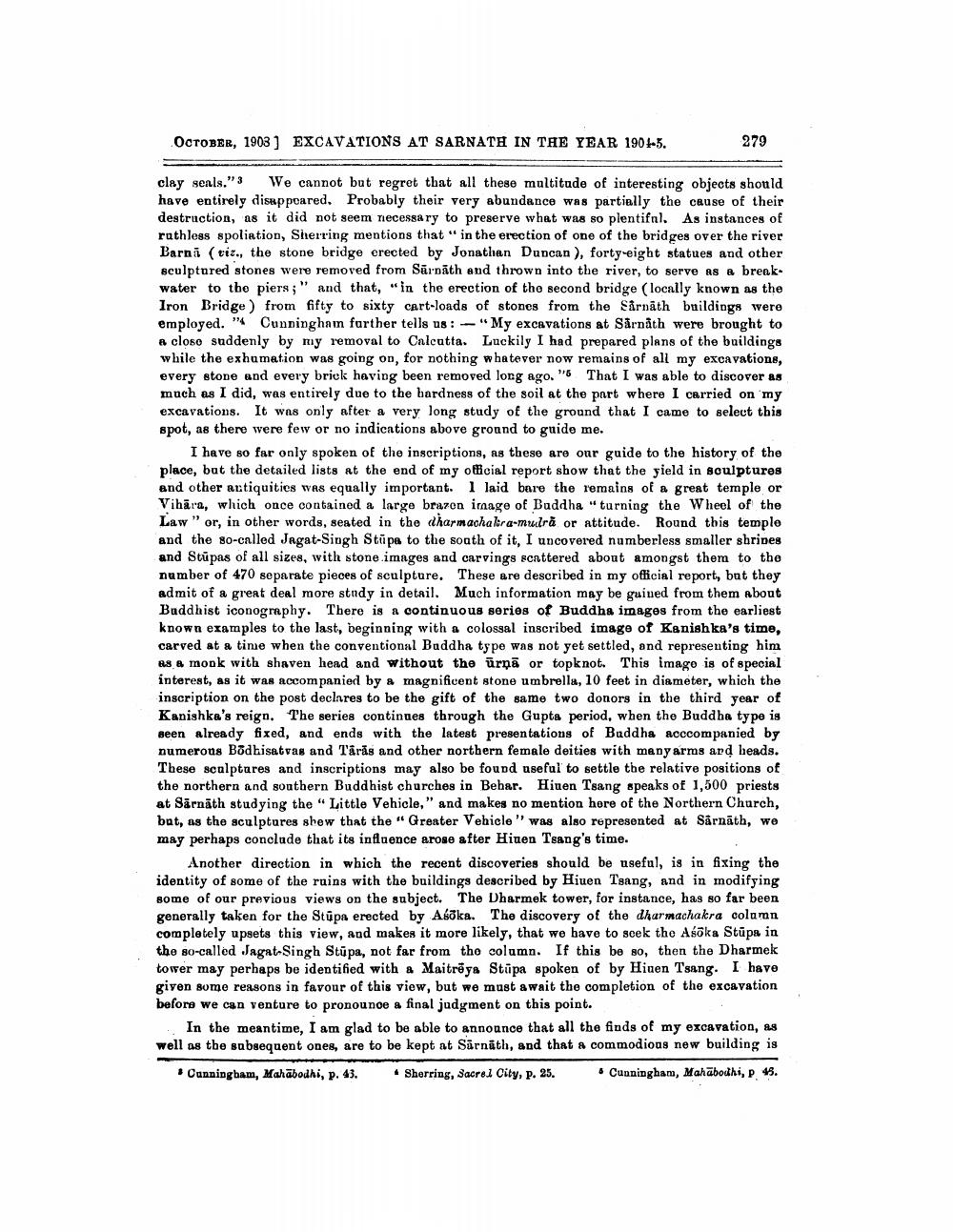________________
OCTOBER, 1903) EXCAVATIONS AT SARNATH IN THE YEAR 1904-5.
279
clay senls." 3 We cannot but regret that all these multitude of interesting objects should have entirely disappeared. Probably their very abundance was partially the cause of their destruction, as it did not seem necessary to preserve what was so plentifnl. As instances of rathless spoliation, Sherring mentions that " in the erection of one of the bridges over the river Barni (tiz., the stone bridge erected by Jonathan Duncan), forty-eight statues and other sculptured stones were removed from Sārnāth and thrown into the river, to serve as a breakwater to the piers;" and that, "in the erection of the second bridge (locally known as the Iron Bridge) from fifty to sixty cart-loads of stones from the Sårnāth buildings were employed." Cunningham farther tells us : -"My excavations at Sarnath were brought to a closo suddenly by my removal to Calcutta. Luckily I had prepared plans of the buildings while the exhumation was going on, for nothing whatever now remains of all my excavations, every stone and every briek having been removed long ago. "5 That I was able to discover as much as I did, was entirely due to the hardness of the soil at the part where I carried on my excavations. It was only after a very long study of the ground that I came to select this spot, as there were few or no indications above ground to guide me.
I have so far only spoken of the inscriptions, as these are our guide to the history of the place, but the detailed lists at the end of my official report show that the yield in sculptures and other actiquities was equally important. I laid bare the remains of a great temple or Vihara, which once contained a large brazon image of Buddha turning the Wheel of the Law" or, in other words, seated in the dharmachalira-mulră or attitude. Round this temple and the so-called Jagat-Singh Stūpa to the soath of it, I uncovered numberless smaller shrines and Stūpas of all sizes, with stone.images and carvings scattered about amongst them to the number of 470 separate pieces of sculpture. These are described in my official report, but they admit of a great deal more study in detail. Much information may be guined from them about Buddhist iconography. There is a continuous series of Buddha images from the earliest known examples to the last, beginning with a colossal inscribed image of Kanishka's time, carved at a time when the conventional Buddha type was not yet settled, and representing him As a monk with shaven head and without the ürņā or topknot. This image is of special interest, as it was accompanied by a magnificent stone umbrella, 10 feet in diameter, which the inscription on the post declares to be the gift of the same two donors in the third year of Kanishka's reign. The series continues through the Gupta period, when the Buddha type is seen already fixed, and ends with the latest presentations of Buddha acccompanied by numerous Bodhisatvas and Tārās and other northern female deities with many arms ard heads. These sculptures and inscriptions may also be found useful to settle the relative positions of the northern and southern Buddhist churches in Bebar. Hiuen Tsang speaks of 1,500 priests at Sārnāth studying the "Little Vehicle," and makes no mention hore of the Northern Church, bat, as the sculptures shew that the "Greater Vehicle' was also represented at Särnāth, we may perhaps conclude that its influence arose after Hiuen Tsang's time.
Another direction in which the recent discoveries should be useful, is in fixing the identity of some of the rains with the buildings described by Hiuen Tsang, and in modifying some of our previous views on the subject. The Dharmek tower, for instance, has so far been generally taken for the Stüpa erected by Asoka. The discovery of the dharmachakra colamn completely upsets this view, and makes it more likely, that we have to seek the Asöka Stūpa in the so-called Jagat-Singh Stūpa, not far from the column. If this be so, then the Dharmek tower may perhaps be identified with a Maitreya Stūpa spoken of by Hinen Tsang. I have given some reasons in favour of this view, but we must await the completion of the excavation before we can venture to pronounce a final judgment on this point.
In the meantime, I am glad to be able to announce that all the finds of my excavation, as well as the subsequent ones, are to be kept at Sārnāth, and that a commodious new building is
* Cunningham, Mahābodhi, p. 43. Sherring, Sacrel City, p. 25. Cunningham, Mahabodhi, P 18.




